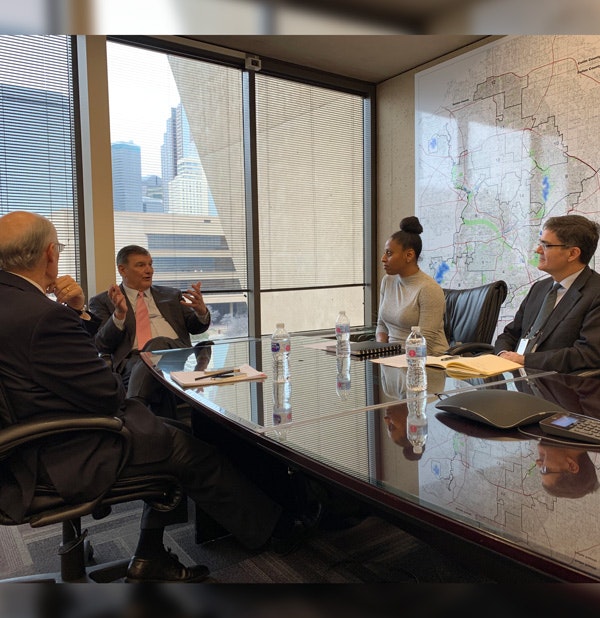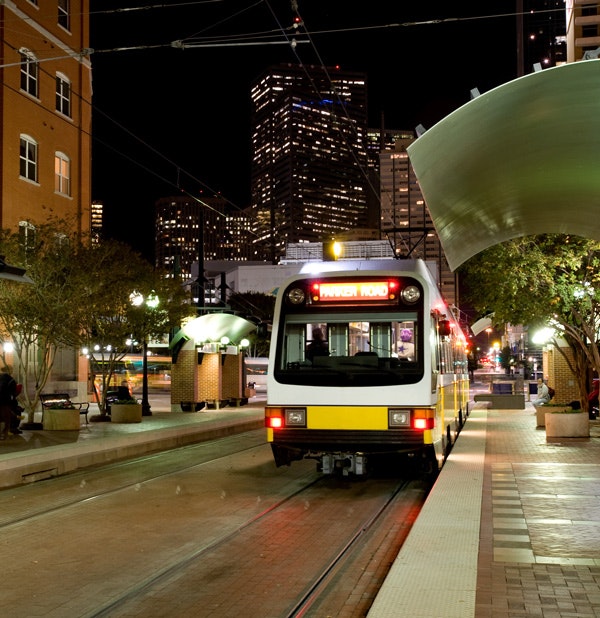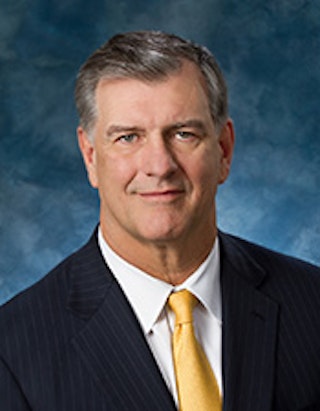Cities Need Goals and Capital to Fight Poverty
Tackling poverty requires more than great ideas. In Dallas, the GrowSouth initiative helped to bring economic opportunity to an underutilized region through public-private partnerships.
 Dallas Mayor Mike Rawlings (second from left) meets with the Bush Institute's (left to right) William McKenzie, Enisha Williams, and Cullum Clark. (Andrew Kaufmann / George W. Bush Presidential Center)
Dallas Mayor Mike Rawlings (second from left) meets with the Bush Institute's (left to right) William McKenzie, Enisha Williams, and Cullum Clark. (Andrew Kaufmann / George W. Bush Presidential Center)
Mike Rawlings was elected mayor of Dallas in May 2011. His final term of office ends in May, so The Catalyst asked the former CEO of Pizza Hut and the TracyLocke advertising agency to reflect back upon GrowSouth, his signature effort to expand economic opportunity in historically-underdeveloped southern Dallas. Comprising more than half of the city’s land mass, southern Dallas contains only 15 percent of its tax base. What worked? What didn’t work? And what lessons might other mayors learn from this effort? Cullum Clark, director of the Bush Institute-SMU Economic Growth Initiative; Enisha Williams, senior program manager in leadership programs at the Bush Institute; and William McKenzie, editor of The Catalyst, put these questions to Mayor Rawlings in a conversation at his City Hall office.
Let’s go back to when you were first elected mayor in 2011. How did you decide to focus on southern Dallas?
I’ve always believed that people should want to do something, not be someone. The question was, what did I want to do?
As I looked at Dallas, nobody had made a significant difference in southern Dallas. I also realized that I was dealing with an issue that had a lot of scale. Southern Dallas is 55 percent of the city’s land mass and the most beautiful part of our city. As a business person, I looked at it as a tremendous underplayed asset that we could use to grow our city. In business, you want an “unfair advantage.” I felt southern Dallas could be our unfair advantage because it is so big and powerful.
Seven years in, what has worked?
The aligning of our city and citizens about the importance of southern Dallas has definitely worked. Our people understand our city better. They see it as a broad, complex place with many different neighborhoods — and southern Dallas is that.
The aligning of our city and citizens about the importance of southern Dallas has definitely worked. Our people understand our city better.
There also are 15 or 20 projects that have worked individually, whether that is the new golf course that hosts a PGA event in southern Dallas, the growth that has happened in West Dallas, or the merchants that are coming back to Jefferson Boulevard. Many projects have worked.
 A storefront on Jefferson Boulevard in southern Dallas. (Andrew Kaufmann / George W. Bush Presidential Center)
A storefront on Jefferson Boulevard in southern Dallas. (Andrew Kaufmann / George W. Bush Presidential Center)
Third, I am proud that we have more community groups and more active citizens in southern Dallas than eight years ago. Those are important for quality-of-life reasons, and they can lead to more retail.
And lastly, we have a new group of young generational leaders and citizens moving back to southern Dallas. Young people are moving back. So are working-class families. They can afford the homes and are creating stronger, bigger neighborhoods.
What has worked in attracting private capital to this under-developed region? And what hasn’t worked?
What has worked are the big projects. For example, we got a Walmart and a shopping center in the middle of a neighborhood that lacked retailers, grocery stores, and restaurants. Capital is coming in there.
Second, home builders have seen southern Dallas as an option. We’ve seen 2,200 new starts since 2015. We started back then taking down barriers to home builders. That capital has worked.
And third, debt financing has become easier. I found that out the hard way. We put together a $35 million fund to provide gap-financing for large projects. Now other debt providers like insurance companies are lending money. We are not out of the woods. But money is cheaper.
How do you persuade people in the business community that they have a good investment opportunity in southern Dallas? Or that they should care about this part of the city?
They will decide on their own if they care. I am not a preacher on that. I talk instead about the vision of Dallas and how southern Dallas can help Dallas achieve its vision.
I did this through getting people on buses and taking them through parts of the city that they had not seen much of before. They were exhausted by the time they got off the bus because there were so many opportunities. They saw what I saw.
The second thing was seeing how these projects had worked out. I found out that people were interested in the idea about southern Dallas but they got passionate when they locked into a specific project that they owned. People will take a project they love, like the [Dallas Independent School District’s] Barack Obama Leadership Academy, and learn about a neighborhood’s opportunities.
What would you say to your successor — or to mayors around the country — about creating partnerships to take on these kinds of challenges?
I’m fortunate because I come from the private sector. I also believe in the line that necessity is the mother of invention. I came to the city and realized that the city’s money was mostly committed to public safety and other things. I had all these ideas but wondered how we would get them done. I said the answer is the private sector.
I had all these ideas but wondered how we would get them done. I said the answer is the private sector.
I realized that especially large businesses were trying to figure out how they could make a difference in their community. So, I thought, let’s create public-private partnerships and release these folks on southern Dallas.
Our next mayor, or new mayors around the country, may come from another background and look at the private sector with some threatening sense about what that group is going to do to our city versus for our city. I knew they could do something for our city. Then, it was just putting on my salesman shoes and putting a plan together. People leapt at the chance.
 This Starbucks in southern Dallas (pictured at its grand opening in November 2018) is part of the GrowSouth initiative in Dallas. The concept location features local talent and locally-sourced foods. (via <a href="https://twitter.com/Mike_Rawlings/status/1068184732683444225">@Mike_Rawlings</a> on Twitter)
This Starbucks in southern Dallas (pictured at its grand opening in November 2018) is part of the GrowSouth initiative in Dallas. The concept location features local talent and locally-sourced foods. (via <a href="https://twitter.com/Mike_Rawlings/status/1068184732683444225">@Mike_Rawlings</a> on Twitter)
When we first announced GrowSouth, I raised half a million dollars within three months to essentially run the program, not for major projects. That was not through philanthropists and foundations but through the business community. People were engaged. The business community provided a lot of get up and go. They wanted to be part of the game plan. It was a big thing for Starbucks when it opened up a store near Red Bird Mall [a revitalized southern Dallas shopping center]. And it was a big thing for the community.
What hasn’t worked out as well as you might like?
I didn’t intend it this way but people saw GrowSouth as a political initiative. They were against the mayor or against a white businessman or against an “establishment person” or however they wanted to frame me. The criticism was that GrowSouth wasn’t of substance. Some thought the project didn’t impact their life and didn’t impact it immediately.
Some of those points of view are legitimate. This is a big challenge with many people that it didn’t impact. What I should’ve done at the outset is communicate better with community organizations about what we were doing. I was too busy trying to do the work as opposed to communicating.
What you learn in this business early on is that people want to be involved. That takes time and patience because people don’t quite understand what you’re doing but think it is important. I did annual updates as much as to give people a chance to hear more about GrowSouth. I was always surprised how packed the room was for those updates.
What you learn in this business early on is that people want to be involved. That takes time and patience because people don’t quite understand what you’re doing but think it is important.
The second thing I have realized is that a deeper issue for southern Dallas is entrepreneurial talent. People look at career paths in a different fashion. You have a lot of good people getting educations but you don’t have folks that want a piece of equity to build something. They may start a salon, a bakery, or a micro business. But we don’t have enough minority developers in this town. Money could be flowing to them, but I probably didn’t spend enough time on the development of people.
And what about affordable housing for lower- and middle-income people?
I have always taken people literally at their word that they want more grocery stores, more book stores, and more restaurants. We provided that, but then people said I believed in gentrification and that I was going to be kicking people out of their affordable housing. But when you have economic development, property values go up, and people start moving around.
I realized that a very few people own all the homes in southern Dallas. And we have a tremendous amount of single-family homes that were built 70 years ago. Everyone is always talking about how bad everything is with these homes. So we got the owners in a room to ask them to increase their standards. But there is an economic cost to improving those standards. I got into a tiff with one owner who said he was going to kick everybody out and that the mayor wanted to gentrify.
It is important to understand how economic development can impact the rent of working-class folks. And that leads you into affordable housing. We have a significant issue in affordable housing in this city. People believe that we can come up with three strategies and it’ll go away. Strategies are important, but it’s really going to take decision after decision after decision, including zoning decisions.
The bigger issue is the will of our neighborhoods to accept and embrace affordable housing. I am not trying to make opponents out to be bad people, but affordable housing doesn’t get built in neighborhoods when groups of people get together to tell their elected officials not to let it happen. We can have all the policies we want, but we have to get moving neighborhood-by-neighborhood.
Last year, a school district north of Dallas couldn’t get its kids to school because the district didn’t have enough bus drivers. The community was too expensive for them to live in. What have you learned about the disconnection between the location of jobs and workers’ ability to get to them?
First, I would tell those businesses that they’ll be better off in Dallas because they’ll be closer to the workforce. That is one of the reasons we’re more successful. I see businesses coming back to Dallas more and more.
But we have this issue in Dallas as well. The biggest employment group is in a hospital district that is not near where most of the people that work in those jobs live. That is why transportation decisions are very important. When money is being spent on infrastructure, economic development happens. You cannot starve southern Dallas of infrastructure development, which is why I worked to get funding for the Southern Gateway Project.
The other thing is jobs need to come to southern Dallas. I am very proud of the warehouse and logistic jobs that we have created that pay $15-$18 dollars an hour. People are working in places that they can live near.
 Dallas Area Rapid Transit (DART) light rail systems have expanded in recent years, filling out a hub-and-spoke model (via Shutterstock)
Dallas Area Rapid Transit (DART) light rail systems have expanded in recent years, filling out a hub-and-spoke model (via Shutterstock)
The issue is really about mass transportation. What does that mean by the year 2030? We have had hub-and-spoke systems, but we’ve got to get much more creative moving people from Point A to Point B.
The issue is really about mass transportation … we’ve got to get much more creative moving people from Point A to Point B.
So, big picture view: What lessons would you offer mayors across the country or your successor about combating poverty in general?
To be honest, I shied away from that for several years. GrowSouth was an economic development project and we’d get more jobs through it. But poverty itself has a lot of root causes.
The big insight for me was we needed everybody in the field to deal with poverty and we needed to align around that. That is why we have created the Child Poverty Action Lab over the last couple of years. It is focused on strategy, not delivering services.
But we have a collective leadership council of CEOs of every organization that deals with poverty from a governmental standpoint. For the first time, all these people from the worlds of education, health care, transportation, and elsewhere are working together in a way that will make the most impact.
I have learned being a mayor that government partnerships are tough to do because you have politicians with different agendas. But things start to come together if you go to the staff and show them the value of a project.
My coaching to my successors and mayors around the country is don’t try to do it all yourself. Try to put an organization together that brings value to the members of that organization. And don’t just talk about ideas — have actual goals. Our goal is to cut childhood poverty by half in one generation. It can be done, but we have to start with teenage pregnancy, we have to improve mobility so people can get to jobs, and we need job training.
My coaching to my successors and mayors around the country is don’t try to do it all yourself. Try to put an organization together that brings value to the members of that organization. And don’t just talk about ideas — have actual goals.
I just learned that people aren’t taking us up on job training because they can’t afford to quit the $13-an-hour job to get trained for the other job. It is discovering those things and getting us all to pull in the same direction.
We can look poverty in the eye and ultimately do something with it. It’s scary because it feels like you’re boiling the ocean. But there are good, fiscally-sound programs to deal with this issue.
The Catalyst believes that ideas matter. We aim to stimulate debate on the most important issues of the day, featuring a range of arguments that are constructive, high-minded, and share our core values of freedom, opportunity, accountability, and compassion. To that end, we seek out ideas that may challenge us, and the authors’ views presented here are their own; The Catalyst does not endorse any particular policy, politician, or party.

